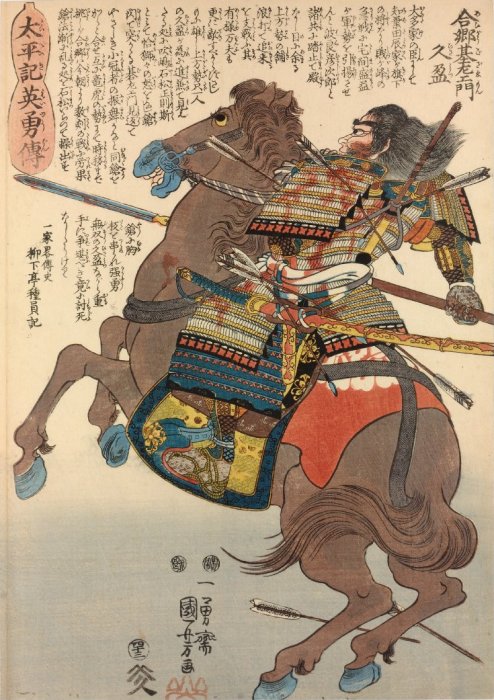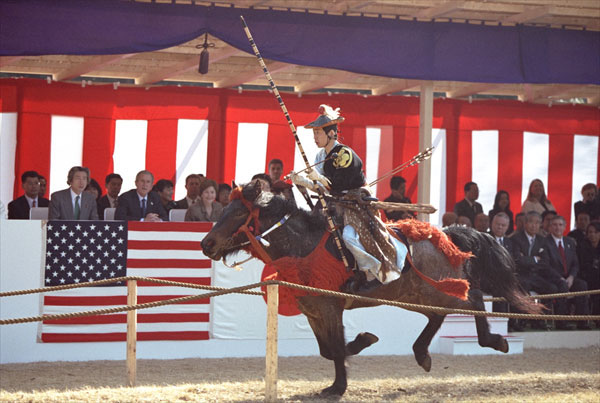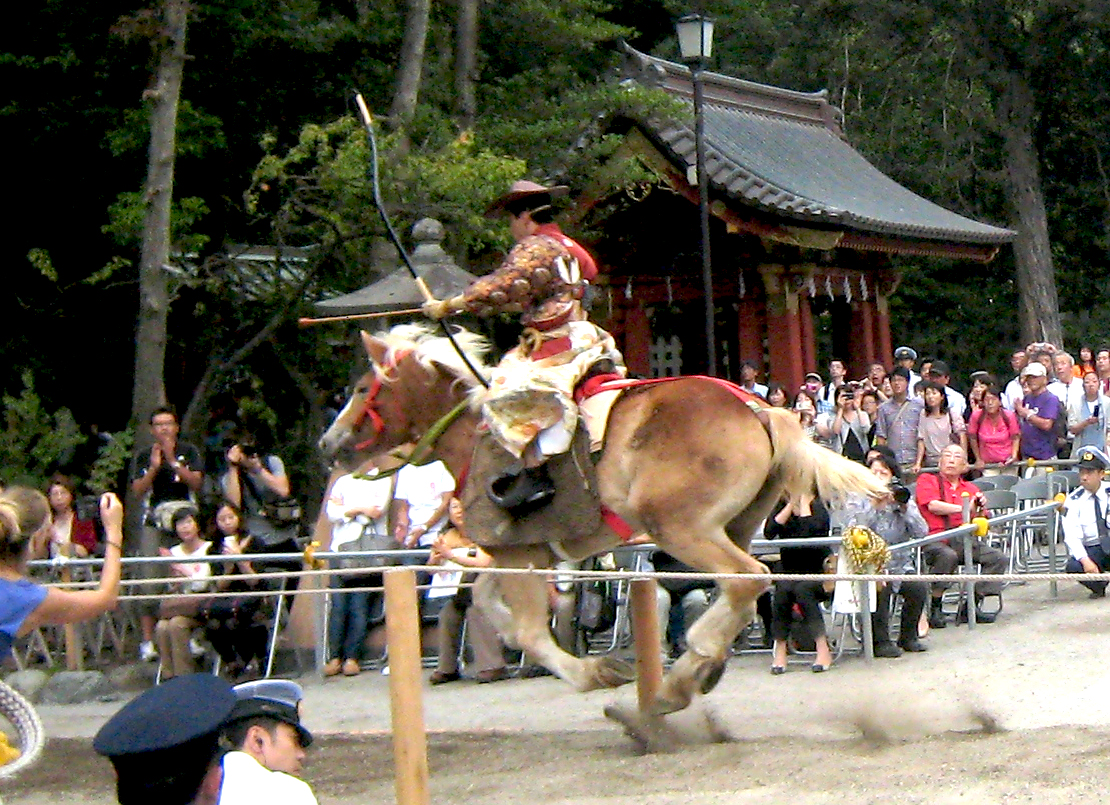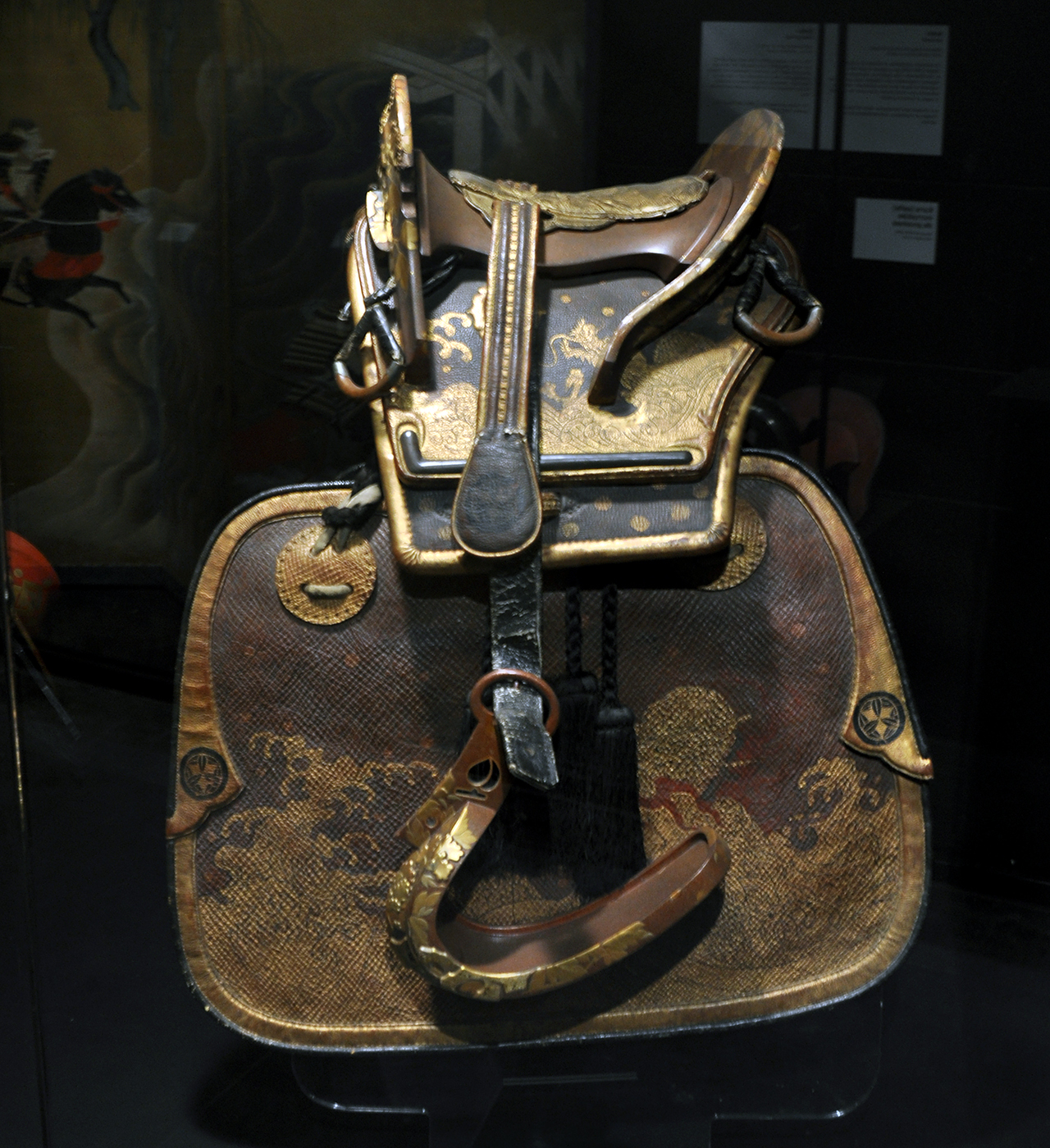|
Bajutsu
is a Japanese form of military equestrianism. History Although its origins are closely related to those of mounted archery (''yabusame''), bajutsu is considered a distinct and separate martial art, and there are a number of traditional schools, such as the Ogasawara, Otsubo, and Hachijo. The art originated in the 7th century AD during the reign of Emperor Tenji but was popularised in the 12th century as large-scale mounted warfare became more common. However, the comparative scarcity of horses in Japan meant that bajutsu was always an elite art, restricted to high-ranking samurai.Lowry, d; ''The Karate Way: Discovering the Spirit of Practice'' Shambhala Publications, 2009 p55 In spite of this, many contemporary historians ignored the numbers of foot-soldiers in battles and referred to the size of armies by the number of horsemen alone. Friday, Karl; ''Samurai, warfare and the state in early medieval Japan'' Psychology Press, 2004 p96-101 The comparative peace of the Tokugawa er ... [...More Info...] [...Related Items...] OR: [Wikipedia] [Google] [Baidu] |
Yabusame
is a type of mounted archery in traditional Japanese archery. An archer on a running horse shoots three special "turnip-headed" arrows successively at three wooden targets. This style of archery has its origins at the beginning of the Kamakura period. Minamoto no Yoritomo became alarmed at the lack of archery skills his samurai possessed. He organized yabusame as a form of practice. Nowadays, the best places to see yabusame performed are at the Tsurugaoka Hachiman-gū in Kamakura and Shimogamo Shrine in Kyoto (during Aoi Matsuri in early May). It is also performed in Samukawa and on the beach at Zushi, as well as other locations. History Japanese bows date back to prehistoric times – the Jōmon period. The long, unique asymmetrical bow style with the grip below the center emerged under the Yayoi culture (300 BC – 300 AD). Bows became the symbol of authority and power. The legendary first emperor of Japan, Emperor Jimmu, is always depicted carrying a bow. Some Emi ... [...More Info...] [...Related Items...] OR: [Wikipedia] [Google] [Baidu] |
Yabusame
is a type of mounted archery in traditional Japanese archery. An archer on a running horse shoots three special "turnip-headed" arrows successively at three wooden targets. This style of archery has its origins at the beginning of the Kamakura period. Minamoto no Yoritomo became alarmed at the lack of archery skills his samurai possessed. He organized yabusame as a form of practice. Nowadays, the best places to see yabusame performed are at the Tsurugaoka Hachiman-gū in Kamakura and Shimogamo Shrine in Kyoto (during Aoi Matsuri in early May). It is also performed in Samukawa and on the beach at Zushi, as well as other locations. History Japanese bows date back to prehistoric times – the Jōmon period. The long, unique asymmetrical bow style with the grip below the center emerged under the Yayoi culture (300 BC – 300 AD). Bows became the symbol of authority and power. The legendary first emperor of Japan, Emperor Jimmu, is always depicted carrying a bow. Some Emi ... [...More Info...] [...Related Items...] OR: [Wikipedia] [Google] [Baidu] |
Horse Racing In Japan
; Horse racing in Japan is a popular equestrian sport, with more than 21,000 horse races held each year. There are three types of racing that take place in Japan - flat racing, jump racing, and Ban'ei Racing (also called Draft Racing). In Japan, horse racing is organized by the Japan Racing Association (JRA) and the National Association of Racing (NAR). The JRA is responsible for horseracing events at ten major racecourses in metropolitan areas, while the NAR is responsible for various local horseracing events throughout Japan. This system of administration of horse racing is unique to Japan. Japan's top stakes races are run in the spring, autumn, and winter; the top race is the Japan Cup. History The history of equestrian sports and horse racing in Japan goes back many centuries, but it was not until the Spring of 1862 that the first horse race in a recognizably European format was organized by a group of British residents on an area of drained marshland just outside the rece ... [...More Info...] [...Related Items...] OR: [Wikipedia] [Google] [Baidu] |
Equestrianism
Equestrianism (from Latin , , , 'horseman', 'horse'), commonly known as horse riding (Commonwealth English) or horseback riding (American English), includes the disciplines of riding, Driving (horse), driving, and Equestrian vaulting, vaulting. This broad description includes the use of horses for practical working animal, working purposes, transportation, recreational activities, artistic or cultural exercises, and animals in sport, competitive sport. Overview of equestrian activities Horses are horse training, trained and ridden for practical working purposes, such as in Mounted police, police work or for controlling herd animals on a ranch. They are also used in Horse#Sport, competitive sports including dressage, endurance riding, eventing, reining, show jumping, tent pegging, equestrian vaulting, vaulting, polo, horse racing, driving (horse), driving, and rodeo (see additional equestrian sports listed later in this article for more examples). Some popular forms of competi ... [...More Info...] [...Related Items...] OR: [Wikipedia] [Google] [Baidu] |
Emperor Tenji
, also known as Emperor Tenchi, was the 38th emperor of Japan, Imperial Household Agency (''Kunaichō'')天智天皇 (38)/ref> according to the traditional order of succession.Ponsonby-Fane, Richard. (1959). ''The Imperial House of Japan'', p. 52. Tenji's reign spanned the years from 661 through 672.Titsingh, Isaac. (1834). Traditional narrative He was the son of Emperor Jomei, but was preceded as ruler by his mother Empress Saimei. Prior to his accession, he was known as . Events of Tenji's life As prince, Naka no Ōe played a crucial role in ending the near-total control the Soga clan had over the imperial family. In 644, seeing the Soga continue to gain power, he conspired with Nakatomi no Kamatari and Soga no Kurayamada no Ishikawa no Maro to assassinate Soga no Iruka in what has come to be known as the Isshi Incident. Although the assassination did not go exactly as planned, Iruka was killed, and his father and predecessor, Soga no Emishi, committed suicide soon afte ... [...More Info...] [...Related Items...] OR: [Wikipedia] [Google] [Baidu] |
Samurai
were the hereditary military nobility and officer caste of medieval and early-modern Japan from the late 12th century until their abolition in 1876. They were the well-paid retainers of the '' daimyo'' (the great feudal landholders). They had high prestige and special privileges such as wearing two swords and ''Kiri-sute gomen'' (right to kill anyone of a lower class in certain situations). They cultivated the '' bushido'' codes of martial virtues, indifference to pain, and unflinching loyalty, engaging in many local battles. Though they had predecessors in earlier military and administrative officers, the samurai truly emerged during the Kamakura shogunate, ruling from 1185 to 1333. They became the ruling political class, with significant power but also significant responsibility. During the 13th century, the samurai proved themselves as adept warriors against the invading Mongols. During the peaceful Edo period (1603 to 1868), they became the stewards and chamberlains of ... [...More Info...] [...Related Items...] OR: [Wikipedia] [Google] [Baidu] |
Karl Friday
Karl F. Friday (born 1957) is an American Japanologist. Friday earned a bachelor's degree in Japanese at the University of Kansas in 1979, followed by a master's degree in East Asian languages and culture from the same institution in 1983. He then attended Stanford University to pursue graduate study in history, earning a master of arts degree in 1986, followed by a doctorate in 1989. Friday began his teaching career as an assistant professor at the University of San Diego. In 1990, he joined the faculty of the University of Georgia, where he was successively promoted to associate professor in 1993, and full professor in 1999. Upon retiring in 2012, Friday was granted emeritus status. He later served as Director of the IES Abroad Tokyo Center, and as professor, and currently professor emeritus, at Saitama University, in Japan. Friday specialized in the study of samurai history and culture, including Japanese martial arts. Friday also holds ''menkyo kaiden is a Japanese term me ... [...More Info...] [...Related Items...] OR: [Wikipedia] [Google] [Baidu] |
Tokugawa Shogunate
The Tokugawa shogunate (, Japanese 徳川幕府 ''Tokugawa bakufu''), also known as the , was the military government of Japan during the Edo period from 1603 to 1868. Nussbaum, Louis-Frédéric. (2005)"''Tokugawa-jidai''"in ''Japan Encyclopedia'', p. 978.Nussbaum"''Edo-jidai''"at p. 167. The Tokugawa shogunate was established by Tokugawa Ieyasu after victory at the Battle of Sekigahara, ending the civil wars of the Sengoku period following the collapse of the Ashikaga shogunate. Ieyasu became the ''shōgun,'' and the Tokugawa clan governed Japan from Edo Castle in the eastern city of Edo (Tokyo) along with the ''daimyō'' lords of the ''samurai'' class.Nussbaum"Tokugawa"at p. 976. The Tokugawa shogunate organized Japanese society under the strict Tokugawa class system and banned most foreigners under the isolationist policies of ''Sakoku'' to promote political stability. The Tokugawa shoguns governed Japan in a feudal system, with each ''daimyō'' administering a ''han'' (f ... [...More Info...] [...Related Items...] OR: [Wikipedia] [Google] [Baidu] |
Tokugawa Tsunayoshi
was the fifth ''shōgun'' of the Tokugawa dynasty of Japan. He was the younger brother of Tokugawa Ietsuna, as well as the son of Tokugawa Iemitsu, the grandson of Tokugawa Hidetada, and the great-grandson of Tokugawa Ieyasu.Nussbaum, Louis-Frédéric. (2005). "''Tokugawa, Tsunayoshi''" in ; n.b., Louis-Frédéric is pseudonym of Louis-Frédéric Nussbaum, ''see'Deutsche Nationalbibliothek Authority File. Tsunayoshi is known for instituting animal protection laws, particularly for dogs. This earned him the nickname of "the dog ''shōgun''". He had a dog named Takemaru. Early years (1646–1680) Tokugawa Tsunayoshi was born on February 23, 1646, in Edo. He was the son of Tokugawa Iemitsu by one of his concubines, named Otama, later known as Keishōin 桂昌院 (1627–1705). Tsunayoshi had an elder brother already five years old, who would become the next shogun after Iemitsu's death, Tokugawa Ietsuna. Tsunayoshi was born in Edo and after his birth moved in with his mother to ... [...More Info...] [...Related Items...] OR: [Wikipedia] [Google] [Baidu] |
Abumi (Japanese Stirrup)
, Japanese stirrups, were used in Japan as early as the 5th century, and were a necessary component along with the Japanese saddle (kura) for the use of horses in warfare. Abumi became the type of stirrup used by the samurai class of feudal Japan. History Early abumi were flat-bottomed rings of metal-covered wood, similar to European stirrups. The earliest known examples were excavated from tombs. Cup-shaped stirrups (''tsubo abumi'') that enclosed the front half of the rider's foot eventually replaced the earlier design.Samurai, warfare and the state in early medieval Japan (Google eBook), |
Kura (Japanese Saddle)
, is the generic name for the Japanese saddle. The word "kura" is most commonly associated with the saddle used by the samurai class of feudal Japan. Over time the Japanese added elements of their own until the Japanese saddle became an identifiable style, also known as the samurai saddle. History and description The Japanese were known to be using the Chinese style of saddle during the Nara period (AD 710 to 794), but during the Heian (794 to 1185), changes made to the Chinese saddle led to what we now call the ''kura'' or Japanese saddle. The Chinese style saddle is known as ''karagura'' while the Japanese style is known as ''yamatogura''. In the fourth century AD, the Japanese started using horses in warfare.Nussbaum, Louis Frédéric and Käthe Roth. (2005). "Horses" in citing the ''Kojiki'' and ''Nihon shoki.'' Cavalry proved to be decisive in the Jinshin War of 672–73, in Fujiwara no Hirotsugu's rebellion in 740 and in the revolt of Fujiwara no Nakamaro in 756. Samurai ... [...More Info...] [...Related Items...] OR: [Wikipedia] [Google] [Baidu] |




-by-Utagawa-Kuniyoshi.png)



.jpg)
